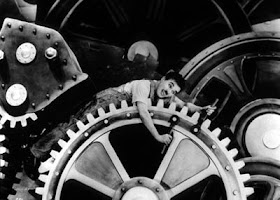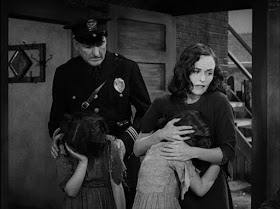You could always recognize "a Chaplin film," but the man rarely allowed his work to succumb to cookie-cutter sameness. Here we can see a difference right from the get-go, with the introductory card that reads: "'Modern Times'. A story of industry, of individual enterprise ~ humanity crusading in the pursuit of happiness." What we have is not just a story about a funny little man, but a morality fable, or cautionary tale, about people on the chuckholed road to the American Dream.
Created almost a full decade after the beginning of movie sound technology yet exhibiting its director's belief that movies didn't need dialogue to communicate effectively, Modern Times was Chaplin's final film to star the Little Tramp, and the difference between this Tramp and his formative years in the earlier classic shorts and features (1914-31) is worth noting.
Back then he was a little fellow alone in a nascent society of other immigrants and vagabonds and petty miscreants. Now in Modern Times he is billed as "a factory worker," and he doesn't exchange his work overalls for the familiar Tramp outfit until almost twenty minutes have passed. In earlier films the Tramp was an underdog up against the authorities or a unibrowed bully or the Alaskan frontier. Now he's a more emblematic Everyman, and his antagonist is society itself. The enemy is named in the movie's title.
And wow — what a stylized look at the Machine Age this is! Our modern times are memorably represented in gargantuan dynamos that could have blazed from the cover of Amazing Stories magazine. The factory's boss — when he's not playing with puzzles or reading comic strips — observes the workers via giant two-way video screens. (The sparking Jacob's Ladder alongside his screen is a nice Frankenstein touch.) The Tramp can't even take a break for a smoke in the washroom without his sour-faced boss' wall-sized Big Brother mug (pre-Orwell, mind you) appearing and barking orders to get back to work. When the boss picks up a newspaper, we can imagine him reading about that nasty business involving the scientist Rotwang across the sea in the German super-city of Metropolis.
| Al Ernest Garcia, uncredited, played the President of Electro Steel Corp. His film career dated back to 1911. In 1928 Chaplin gave him a credited role as the Ring Master in The Circus. He also appeared in City Lights, The Gold Rush, and a few of Chaplin's earlier shorts. This was one of his last films. |
Or take the "Billows Feeding Machine" sequence. Thanks to a mechanical salesman that speaks via a phonograph record (with one significant exception near the end of the film, all human voices in Modern Times speak only through machines), the boss tests a new contraption designed to increase efficiency by eliminating a worker's lunch hour. The feeding machine is a chrome monstrosity, all jointed metal arms and servos, like something that would come crashing through the walls of a robot dentist's office. The recording exhorts us to admire "its beautiful, aerodynamic, streamlined body, its smoothness of action, made silent by our electro-porous metal ball bearing," and so on with all the language-abusing manipulations of modern product marketing copy.
The Tramp is conscripted to test the device, and one of Chaplin's most inspired scenes arrives when the gizmo goes haywire with the Tramp trapped like a torture victim by mechanical arms shoveling food into his mouth or onto his face, while the automatic "sterilized mouth wiper" keeps dutifully patting his mouth until, berserk, it whacks bang-bang-bang his besmeared face. What's the boss' opinion after he's witnessed his employee abused in such an undignified fashion? "It isn't practical."
Soon we come one of Chaplin's indelible images. It's the crazed Tramp being drawn into The Machine, where he's threaded through giant cogwheels, stopping only to blithely tighten another pair of bolts.
Right there Chaplin's genius hands us an ageless visual metaphor, one that any 21st Century employee who has clipped a Dilbert cartoon will greet with a knowing smile. Chaplin almost certainly planted a personal message of his own in those gears that grab and digest the Tramp: They look suspiciously like the threading path of a motion picture camera. The Tramp, a creation of pantomime in a medium that by '36 was all about sound, is overtaken by mechanization. After Modern Times he is never seen again.
Driven to the brink by it all, our bedeviled factory worker goes stark raving nuts. Like a man hypnotized, he wields his wrenches like weapons, tightening everything, such as the buttons on the back of a secretary's dress, before chasing after a bosomy matron with her own pair of ill-placed fashionable "bolts."
Fortunately, with insanity comes freedom. Released from his machine-like life, the Tramp dances and twirls in giddy drunken glee. Instead of robot-like repetition, his movements are now balletic, spontaneous, human. Wearing an enraptured — enlightened? — smile, he traipses about sabotaging the machinery and his fellow drones until he's captured and sent to a hospital to be "cured."
This is Chaplin's rage against the machine. In lesser hands, such industrial strength social commentary would be a blunt-object diatribe like H.G. Wells' Things to Come, released the same year. But this is Chaplin, so even pointing a lens at the soul-eating inhumanity of the workplace gives us a comic parable. Unlike Wells' technofetish polemic, Modern Times remains fresh for the 21st Century by living up to its title.
The YouTube clip below deletes the Billows Feeding Machine segment (replacing it with an intertitle card at the 4:38 mark), but otherwise the factory sequence is intact:
In this YouTube clip, the Billows Feeding Machine sequence starts just after the 3:00 mark. Unfortunately the clip ends before the sequence's wham-bam climax, and (at the time I write this) the follow-up clip has been deleted from YouTube:
There's plenty more to Modern Times, of course. After the factory worker is sent to the hospital, Chaplin abandons the "science fiction" scenario to follow the Tramp, now back in his famous too-tight jacket and baggy pants, into the outside "real" world. It's a world of hunger, political inequality, and good people getting by as best they can against powerful oppressive forces. The episodic structure uses comedy to pin down like beetles other contemporary topics much on Chaplin's mind. His takes on unemployment, poverty, drugs, strikes, strike-busting, and riots still pack a wallop of modern currency.
But it's the factory sequence that Modern Times is most remembered for, and you don't have to be a hardcore Chaplin fan to recognize "the one with the guy in the gears."
By employing science-fiction-like motifs (not that he'd use that term) to point an observant finger at the rumbling age of mechanized industrialization, Chaplin wasn't inventing allegorical musings out of whole cloth. Instead he was elevating and popularizing themes that had already been bubbling up in films and literature during the anxiety-making cultural and technological changes of the 1920s and 1930s.
As early as 1909, E.M. Forster's story "The Machine Stops" depicted a future of mechanized isolation that presages our current Internet age. Fritz Lang's slaves-to-the-machines fable Metropolis was nine years old by '36.
Assembly-line humanity features starkly in Aldous Huxley's novel Brave New World (1931), which opens in the "year of our Ford 632." 1931 also saw the issue of Modern Mechanics that asked "Is Man Doomed by the Machine Age?" ("Yet the present era of industrial depression, with millions of men thrown out of work—as some maintain, because machines have taken their places, working swifter and cheaper—has seen a renewal of the outcry against machinery.")
 |
| From Modern Mechanics and Inventions, March 1931 |
 |
| From the San Antonio Light, April 2, 1939 |
A German film from '34, Master of the World, features malevolent industrial robots and war machines threatening human labor and lives. H.G. Wells' own screenplay to 1936's Things to Come, which I've already mentioned, presents a civilization destroyed by machines of war and then revived by machines of creation and prosperity.
Later movies, such as the 1951 English serio-comedy The Man in the White Suit, use science fictional elements as a means for social or topical commentary in ways that Chaplin would, I think, applaud.
Probably reflecting the mood of our (modern) times, dire dystopian science fiction is on the rise again, both in the movies and on the book shelves. Yet as far as I can see, there's not a modern Chaplin out there saying that if this really is a Brave New World, we might as well go ahead and laugh at it. On second thought, there's Jon Stewart. That's good enough for me.
(From here on I'm simply giving myself an excuse to post pictures of Paulette Goddard from the film, as if I really need a reason beyond the obvious.)
But running through the heart of it all is a love story between the Tramp and the "gamin," a "child of the waterfront, who refuses to go hungry." We meet her stealing bananas from a shipyard loading dock, tossing the food up to a gaggle of hungry street urchins. She is spirited and vivacious, almost feral. Alternately wild and coquettish, she sports the haughty swagger of a Robin Hood outlaw, then sweetly looks after her father ("one of the unemployed") and her two young sisters.
She's played by Paulette Goddard, one of the great classic Hollywood beauties (and eventually the best ex-Mrs. Chaplin).
Goddard was Chaplin's third wife, and is handily the loveliest and liveliest of his leading ladies. Today, after the better part of a century, her gamin is among the sexiest of ingenues — how many of the Tramp's other love interests first appear onscreen in a short rag dress and with a knife in their teeth?
Unlike previous women the Tramp has fallen for, the gamin is given equal status carrying the movie. The Tramp loves a girl who loves him back. Finally he has a partner. Chaplin called the duo "the only two live spirits in a world of automatons." They're jailbreakers who have busted out of the Establishment and are on the run for their own freedom.
For the rest of the movie they are companions, even sharing a tumbledown shanty together. Chaste? Yes, but Modern Times differs from its predecessors by giving the Tramp someone to share his story with. Neither character is subordinate to the other. Chaplin's message was good enough for Casablanca six years later: In this crazy, mixed up world sometimes all we've got is each other.
Happiness doesn't last, however, and before long the two vagabonds are forced back onto the open road for one of cinema's most wistful exits. Despairing alongside a country road, the gamin sobs, "What's the use of trying?" The Tramp — once again the scruffy no-surrender optimist the world had watched for an entire generation — urges her to "Buck up. Never say die. We'll get along!" Then he reminds her how to put a smile on her face. She agrees, and the spark returns to her eyes.
In Chaplin's best-remembered fade-out, the two tramps set off hand in hand down the dusty road toward a mountainous horizon, silhouetted against a welcoming sunrise. Two survivors, resolute and no longer alone, with the totality of their worldly possessions tied up in kerchief bundles, walk away toward an unknown, but also unprescribed and unmechanized, future.
If you don't think that last shot is a lump-in-the-throater, there's no hope for you.
Music: Muddy Waters, "The Blues Had a Baby and They Named it Rock and Roll"
Near at hand: Framed photo of "Shakespeare and Co." bookshop.









